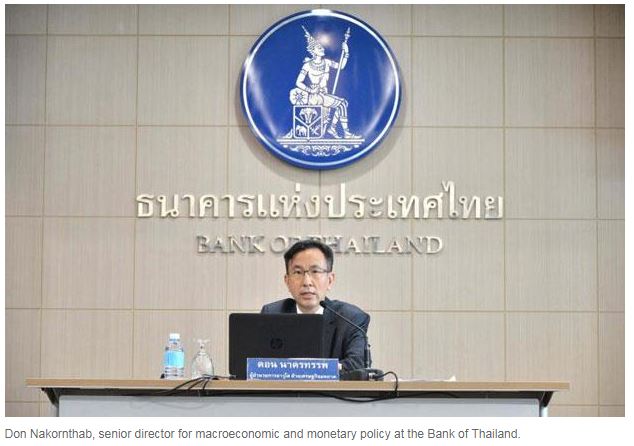Thailand: BoT forecasts 3.9% GDP growth despite weak shipments
Strong domestic demand will partially offset declining exports, leading to higher-than-expected GDP growth of 3.9% this year, says the Bank of Thailand.
The consensus growth projections for Thailand are lower at 3.6%.
Don Nakornthab, senior director for macroeconomic and monetary policy at the Bank of Thailand, said trade tensions may play a role this year in growth, but less so in Thailand than in China and Europe.
He said there may be a deal struck between China and the United States in the coming months, which would reduce long-standing trade tensions and cut risk to Asian supply chains.
According to Mr Don, the key factors to economic growth in Thailand this year will be the US-China trade war, the health of the Chinese economy, the progress of the Eastern Economic Corridor (EEC) and post-election stability.
“Exports will continue to be a drag on the Thai economy but will be partially offset by domestic demand,” Mr Don said. “The EEC policy is expected to remain resilient to political developments, although some projects may be subject to review and alteration.”
He said the EEC project will likely be a main driver of economic growth for years to come.
The Bank of Thailand is unlikely to raise the policy rate, currently at 1.75%, as the bank is satisfied with current levels of inflation.
Shaun Roache, chief economist at S&P Global Ratings Asia-Pacific, said Thailand has the opportunity to capitalise on trade tensions by cutting out small pieces of the supply chain from China’s manufacturing sector.
Multinationals want to reduce their risk, or reliance on China, and will be looking for other regional players to move factories.
“Supply chains are not regional, but global, and companies are much more likely to move their factories to other countries inside the same region,” Mr Roache said. “Countries in the region need to step up and try and take a piece of the China supply chain.”
But according to Kim Eng Tan, senior director for sovereign ratings at S&P Global Ratings Asia-Pacific, investments in Thailand are not as high as they should be, compared with countries with similar income levels and regional competitors like Vietnam and Indonesia.
“Thailand is situated in the most dynamic region in the word today, but investment numbers are only slightly higher than in Cambodia and Malaysia, where a dysfunctional political situation reduced overall investment,” Mr Tan said.
Despite low investment, Thailand’s financial indicators remain strong, he said, with the deficit relatively low at 1% of GDP, while the overall debt remains low as well.
“Just looking at these numbers, the sovereign rating for Thailand is on the upside, but we are still concerned about political uncertainty, which has exacted a cost on the Thai economy,” Mr Tan said.
The government’s flagship development project, the EEC, will most likely survive this political uncertainty, according to Luxmon Attapich, deputy secretary-general of the EEC Office.
“The EEC Act is a law, and whatever happens politically, we will continue our mission,” she said. “Some of the projects may be re-evaluated and amended, but the core project will be kept intact. The campaigns of all political parties expressed the importance of these infrastructure projects and praised the EEC.”
The EEC is a public-private partnership with 32% of the investment coming from the public sector (200 billion baht) and 68% from the private sector (450 billion baht).
The individual projects in the EEC are still in the bidding or negotiation phases, with the farthest-along major project being the high-speed railway connecting Rayong and Bangkok.
“The EEC seems to be a strategy with reasonably good motivation, and I think it is heading the country in the right direction,” Mr Roache said.
Source: https://www.bangkokpost.com/business/news/1652696/bot-forecasts-3-9-gdp-growth-despite-weak-shipments


 Thailand
Thailand




